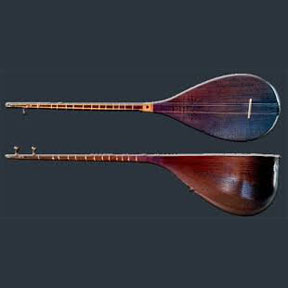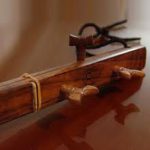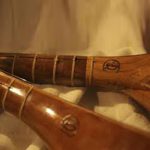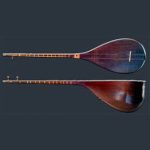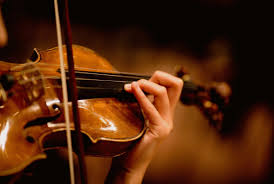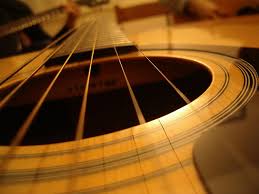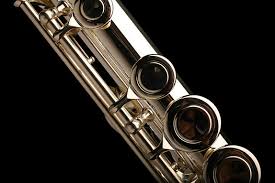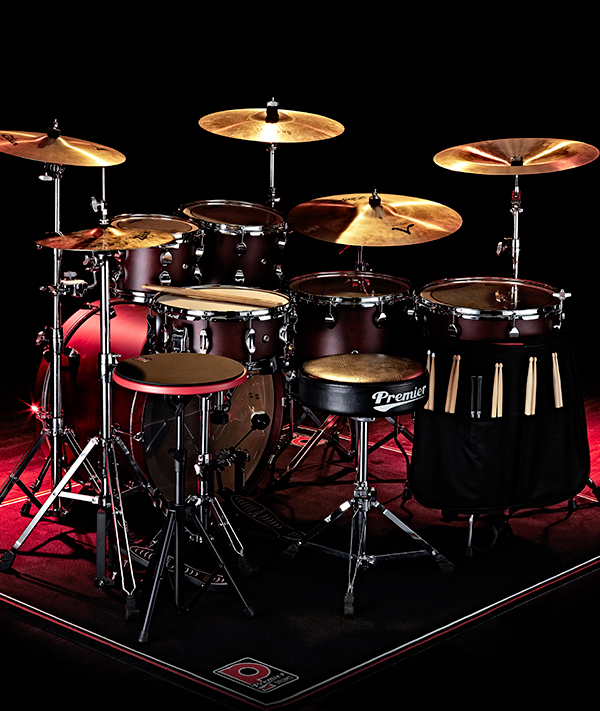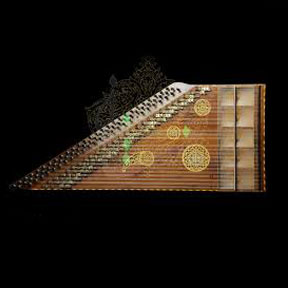The tambour is a traditional Iranian instrument characterized by its long neck and pear-shaped body, typically made from mulberry wood. Its body can be constructed in two styles: a single-piece (traditional) or multi-piece (imitating the setar’s design). The instrument usually measures between 70 to 80 cm in length and has three strings: one for the drone and two for the main melodies. Historically, it had one or two main strings, but today three-string configurations are common. It features fourteen frets (dastan) and lacks quarter-tones. The two common tunings are the Seven-Fret (Barz) and Five-Fret (Tah Reza), with modern players often tuning the main string to C and the drone string to G.
Playing Technique:
The Tambour is played with four fingers of the right hand, without the use of synthetic plectra. The left-hand techniques are similar to other stringed instruments with long necks, such as the tar and setar. The primary plectra are the right, left, and sharp plectra, along with fine and double strokes.
Historical Background:
The Tombak is one of Iran’s oldest instruments, with mystical and ceremonial significance. It features 13 to 14 frets and 2 to 3 strings. The body and face are made from mulberry wood, while the neck is crafted from walnut wood. In the Yarsan regions, the instrument is held in high esteem, and musicians often kiss the frets before and after playing. The Tombak reached its peak during the 5th century AH (Islamic calendar) with the renowned army of Shah Khoshin, and it has been known as the “Shah-Khoshini” instrument throughout Iran. Archaeological findings suggest the Tambour has a history of around 6,000 years, with notable evidence including a statue near the tomb of Daniel in Shush. Although its exact invention date is unclear, the Tambour has been in use long before the advent of Islam.
The Tambour is considered the oldest stringed instrument with a long neck, having both a body and strings. Historical texts and dictionaries, such as the Grove Dictionary of Musical Instruments, estimate its age at 5,000 to 6,000 years. Stone statues and archaeological sites in Shush and the Bani Younis mounds near Mosul date it back 1,500 to 2,000 years before Christ. The Pahlavi texts mention that Ardshir Babakan played the Tambour and sang. Legendary accounts suggest that Rustam played the Tambour in the Fourth Reign and that the “Tah Reza” mode is attributed to him, while “Bariya” is associated with the musician Barbad of the Sassanian court. Scholars like Farabi, Avicenna, Abd al-Qadir Maraghi, and Safi al-Din Urmavi have extensively discussed the Tombak and its various modes and tunings. Prominent Persian poets such as Sheikh Junayd Baghdadi, Ferdowsi, Rumi, Manouchehri Damghani, Nizami Ganjavi, Musavi, Hafiz, Wahid Qazvini, Bidel Dehlavi, and Vafa Kermanshahi have frequently mentioned the Tambour in their works.
Musical Repertoire:
The Tambour`s repertoire includes around 72 modes, with 16 related to ceremonial music and 56 to sacred or spoken music. The music of the Tambour is based on improvisation, similar to classical Iranian music. Musicians can modulate between different modes and return to the original mode, showcasing the instrument’s versatility and depth.

